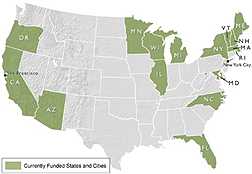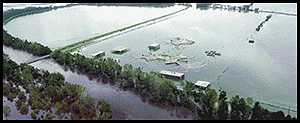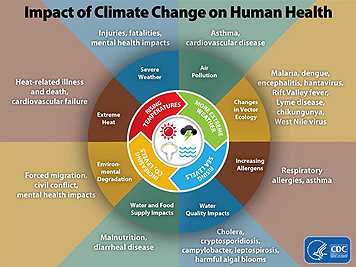CDC's Climate and Health Program - an Investment in our Future
Changes in the climate are already affecting our health. Preparing to address these health effects now will save lives and decrease future health care spending.
Through the Climate Ready States and Cities Initiative, CDC funds and supports 16 states and two cities – 50 percent of the country’s population – in this effort.

The program does not address the causes of climate change – rather, it helps ensure that our communities are adequately prepared for health challenges, including those associated with:
- extreme heat and cold
- severe storms, floods, and droughts
- pollen and air quality
- infectious disease
Children, the elderly, the sick, the poor, and some minority communities are among the most vulnerable to these health effects. More than 10,000 people [PDF – 330 KB] died from extreme weather events from 2006 through 2010. Of those, the death rate from extreme weather doubled for people with incomes under $36,000 versus incomes over $49,000.
CDC empowers state and local officials to keep their communities healthy by helping them:

Wastewater treatment plant, Goldsboro, NC
- Identify and forecast the health impacts in their geographic area.
- For example, North Carolina is vulnerable to storm surge, and is at high risk for flooding, drinking water outages, and waterborne disease.
- Understand gaps in their knowledge and capabilities
- The state needed to identify which communities were most at risk.
- Identify new ways to address health challenges
- The state collaborated with local water authorities to estimate coastal flooding and map at-risk drinking water and wastewater infrastructure.
- Collect critical information to guide resource decisions
- Results are helping North Carolina plan for existing facilities and decide where new facilities are needed.
Research shows that climate changes not only hurt health, but also affect the economy.
$740 million: U.S. direct health care costs spent on 6 climate-related events between 2000 and 2009
$6.5 billion: Estimated U.S. health care costs from current effects of ozone air pollution
$1.4 billion: U.S. health care costs from the four major Florida hurricanes in 2004
Public health actions, especially preparedness and prevention, can do much to protect people from the impacts of climate change. Early action provides the largest health benefits.

Our grantees assess how climate is affecting public health in their communities and work to help people adapt.
|
Increased Extreme-Heat Events
|
16 of 18 grantees are addressing extreme heat. Arizona, Michigan, Minnesota, and San Francisco developed extreme heat response plans. Arizona sends heat warnings and health messages to hospitals, schools, and the public via email and social media. New York City customized a heat alert system to lower the warning trigger temperature. New York City, Maine, and Michigan track extreme heat-associated health conditions. |
|
Changes in Vector and Disease Ecology
|
Vermont reported 674 confirmed cases of Lyme disease in 2013, a 1,500% increase since 2003. Vermont created the “Tick Tracker” web-based surveillance system to track tick-borne disease using reports from residents. In 2014, 294 ticks were reported and geographically tracked, including 176 deer ticks, which can spread Lyme disease. The web site provides pictures and education for residents. |
|
Reduced Air Quality
|
Minnesota developed and conducts training to help local health departments monitor air quality, track asthma and allergies, and improve energy efficiency to reduce production of harmful air pollutants. Arizona, with new tools, helped residents protect themselves from deadly wildfires in 2013. |
- Page last reviewed: October 22, 2015
- Page last updated: October 22, 2015
- Content Source:


 ShareCompartir
ShareCompartir